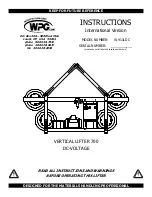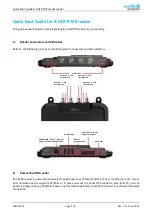
Rev 19.3/9-18
13
VL411LDC: #35162
If the vacuum system experiences leakage while the lifter is attached to the load, the vacuum
pump turns on automatically, as required to maintain sufficient vacuum. The alarm also sounds
while the pump is running, to signal the reduction in vacuum to the operator. If the alarm
sounds while you are lifting a load, make sure the vacuum gauge shows a vacuum level of 16"
Hg [-54 kPa] or higher. If not, immediately move away and stay clear of the load until it can be
lowered to the ground or a stable support.
WARNING: Stay clear of any suspended load while alarm is sounding.
Discontinue lifter use until the cause of the vacuum loss can be determined. Using the lifter on
contaminated, rough or porous surfaces may result in a vacuum loss, due to leakage between
the vacuum pads and the load. Since the alarm may sound in such circumstances, consult the
section T
O
A
PPLY THE
P
ADS TO A
L
OAD
: Vacuum Level on Other Surfaces to determine whether the
lifter can be used to lift the load. If the vacuum loss is due to any other cause, perform
inspection and maintenance as needed to identify and correct any deficiency before resuming
normal operation of the lifter.
Controlling the Lifter and Load
When vacuum indicators show that the lifter is ready, use the hoisting
equipment to raise the lifter and load as needed to clear any obstacles in their
path. Use the control handles to keep the lifter and load in the desired
orientation while they are suspended from the crane.
In Case of Power Failure
The lifter is equipped with a vacuum reserve tank, designed to maintain vacuum temporarily in
case of a power failure (ie, in battery).
WARNING: Stay clear of any suspended load in the event of a power failure.
Although the lifter is designed to support the load for at least 5 minutes without power, this
depends on many factors, including the condition of the load and the lifter’s vacuum system (see
INTENDED USE: L
OAD
C
HARACTERISTICS
and MAINTENANCE: V
ACUUM
P
AD
M
AINTENANCE
,
V
ACUUM
T
EST
). If a power failure occurs, keep all personnel clear of the suspended load until it can
safely be placed on the ground or a stable support. Correct any deficiency before resuming
normal operation of the lifter.
T
O
R
ELEASE THE
P
ADS FROM THE
L
OAD
WARNING: Load must be fully supported before releasing vacuum pads.
When the load is at rest and fully
supported, pinch the valve release lever
against the valve handle, to unlatch the
handle. Then push the valve handle
inward to the “release” ( ) position
(power off), as shown. Do not attempt to
move the lifter until the vacuum pads
disengage completely from the load.
TO RELEASE
Содержание VL411LDC
Страница 2: ......
Страница 30: ...Rev 19 3 9 18 28 VL411LDC 35162...
Страница 31: ...Rev 19 3 9 18 29 VL411LDC 35162...
Страница 32: ...Rev 19 3 9 18 30 VL411LDC 35162...
Страница 33: ...Rev 19 3 9 18 31 VL411LDC 35162...
Страница 34: ...Rev 19 3 9 18 32 VL411LDC 35162...
















































